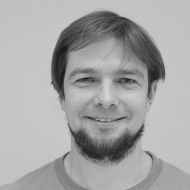
Dr. Daniel Herlemann

Seestrasse 15
D-18119 Rostock
Germany
Research
The taste of salt
The Baltic Sea is characterized by its distinct horizontal and vertical pelagic salinity gradient, with the unique feature that 62 % of its surface zone is represented by brackish conditions (5-8 salinity). Observations concerning the diversity of pelagic microorganisms in the Baltic Sea demonstrated the presence of marine as well as freshwater taxa, but no coherent view exists on the area of a shift between marine and freshwater microorganisms, or the composition of potential brackish water microbial assemblages.
Phylogenetic markers are investigated for transects covering the horizontal and vertical salinity gradient of the whole Baltic Sea. The bacterial diversity and abundance will be studied applying 16S rRNA/rRNA gene Tag pyrosequencing analyses, resulting in the first biogeographical as well as microbial richness mapping of the Baltic Sea on a high resolution, three-dimensional basis.
ATKiM project (coordinator) 2011-2014
Degradability of artic, terrigenous carbon compounds in the Sea (ATKiM)
Recent Publications
Klier J., Dellwig O., Leipe T., Jürgens K., and D.P.R. Herlemann 2018. Benthic bacterial community composition in the oligohaline-marine transition of surface sediments in the Baltic Sea based on rRNA analysis. Front. Microbiol. 2018;9:236.
Wylezich C., Herlemann D.P.R., Jürgens K. 2018. Improved 18S rDNA amplification protocol for assessing protist diversity in oxygen-deficient marine systems. Aquat. Microb. Ecol. (DOI: https://doi.org/10.3354/ame01864)
Herlemann D.P.R., Manecki M., Dittmar T., and K. Jürgens. 2017. Differential responses of marine, mesohaline, and oligohaline bacterial communities to the addition of terrigenous carbon. Environ. Microb.:19, 8, 3098–3117
Seidel M., Manecki M., Herlemann D.P.R., Deutsch B., Schulz-Bull D., Jürgens K. and T. Dittmar. 2017. Composition and transformation of dissolved organic matter in the Baltic Sea. Front. Earth Sci. 5:31. doi: 10.3389/feart.2017.00031
Urubschurov V., Büsing K., Freyer G., Herlemann D.P.R., Souffrant W.B. , and Zeyner A. New insights into the role of the porcine intestinal yeast, Kazachstania slooffiae, in intestinal environment of weaned piglets. FEMS Microbiology Ecology. 2017. Feb 1;93(2):fiw245.
Herlemann D.P.R., Lundin D., Andersson A., Labrenz M., and K Jürgens. 2016 Phylogenetic signals of salinity and season in bacterial community composition across the salinity gradient of the Baltic Sea. Front. Microbiol. 7:1883.
Numberger D., Dehnhardt G., Herlemann D.P.R., Jürgens K., and Schulz-Vogt H.N. 2016. Comparative analysis of the fecal bacterial community of five harbor seals Phoca vitulina. MicrobiologyOpen: doi: 10.1002/mbo3.369
Schäffler H., Herlemann D.P.R., Alberts C., Kaschitzki A., Bodammer P., Bannert K., Köller T., Warnke P., Kreikemeyer B., and G. Lamprecht. 2016 Mucosa-attached bacterial community in Crohn’s Disease coheres with the Clinical Disease Activity Index. Environ Microb Rep.: 8; 5 614–621
Otto S., Erdmann S., Streibel T., Herlemann D.P.R., Schulz-Bull D. Zimmermann R. 2016 Pyrolysis-gas chromatography-mass spectrometry with electron-ionization and resonance-enhanced-multi-photon-ionization for the characterization of terrestrial dissolved organic matter in the Baltic Sea. Anal. Methods, 8, 2592-2603
Curriculum vitae
- since 2009 Leibniz Institute for Baltic Sea Research, Warnemünde; Postdoc
- 2006 –2009 Max Planck Institute for Terrestrial
Microbiology Marburg, Germany.
Doctor of natural science (Ph.D.) - 2005 External
diploma thesis at the
Helmholtz Centre for Environmental research (UFZ), Leipzig. - 2003 Semester abroad (ERASMUS) at the University of Klaipeda, Lithuania
- 2000- 2005 Ernst-Moritz-Arndt University Greifswald, Diplom
Publications before 2016
Rieck, A., Herlemann D.P.R., Jürgens K. and Grossart H.-P. 2015. Particle-associated differ from free-living bacteria in surface waters of the Baltic Sea. Front. Microbiol. 6:1297. doi: 10.3389/fmicb.2015.01297
Bergen, B., Herlemann, D.P.R. and Jürgens, K. 2015. Zonation of bacterioplankton communities along aging upwelled water in the northern Benguela upwelling. Front. Microbiol. 6:621. doi: 10.3389/fmicb.2015.00621
Herlemann D.P.R., Woelk J., Labrenz M., and K.Jürgens. 2014. Diversity and abundance of “Pelagibacterales” (SAR11) in the Baltic Sea salinity gradient. Syst. Appl. Microbiol: 37, 601–604
Bergen, B., Herlemann, D.P.R., Labrenz, M., and K. Jürgens. 2014. Distribution of the verrucomicrobial clade Spartobacteria along a salinity gradient in the Baltic Sea. Environ Microb: 6, 625–630
Schulz-Bull D., Dittmar T., and K. Jürgens. 2014.Uncoupling of bacterial and terrigenous dissolved organic matter dynamics in decomposition experiments. PLoS ONE 9(4): e93945.
Herlemann D.P.R., Lundin D., Labrenz M., Jürgens K., Zheng Z., Aspeborg H., and A.F. Andersson. 2013. Metagenomic de novo assembly of an aquatic representative of the verrucomicrobial class Spartobacteria. mBio 4(3):e00569-12.
Herlemann D.P.R., Labrenz M., Jürgens K., Bertilsson S., Waniek J.J., and A.F. Andersson. 2011, Transitions in bacterial communities along the 2000 km salinity gradient of the Baltic Sea. ISMEJ 5: 1571–1579.
Herlemann D.P.R., Geissinger, O., Ikeda-Ohtsubo, W., Kunin, V., Sun, H, Lapidus A., Hugenholtz P., and A. Brune. 2009. Genome analysis of Elusimicrobium minutum, the first cultivated representative of the Elusimicrobia phylum (formerly Termite Group 1). Appl Environ Microbiol: 75, 2841-2849
Geissinger O., Herlemann, D.P.R., Maier U., and A. Brune. 2009. Elusimicrobium minutum gen. nov., the first isolate of the Termite Group 1 phylum. Appl Environ Microbiol: 75, 2831-2840.
Herlemann D.P.R., Geissinger, O., and A. Brune. 2007. The Termite Group 1 phylum is highly diverse and widespread in the environment. Appl Environ Microbiol: 73, 6682-6685.